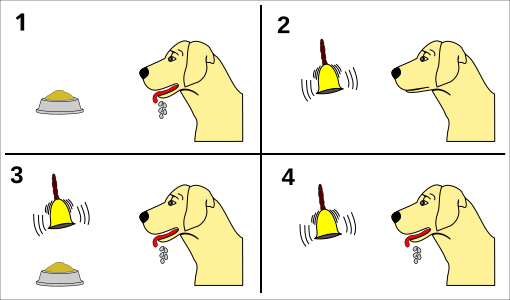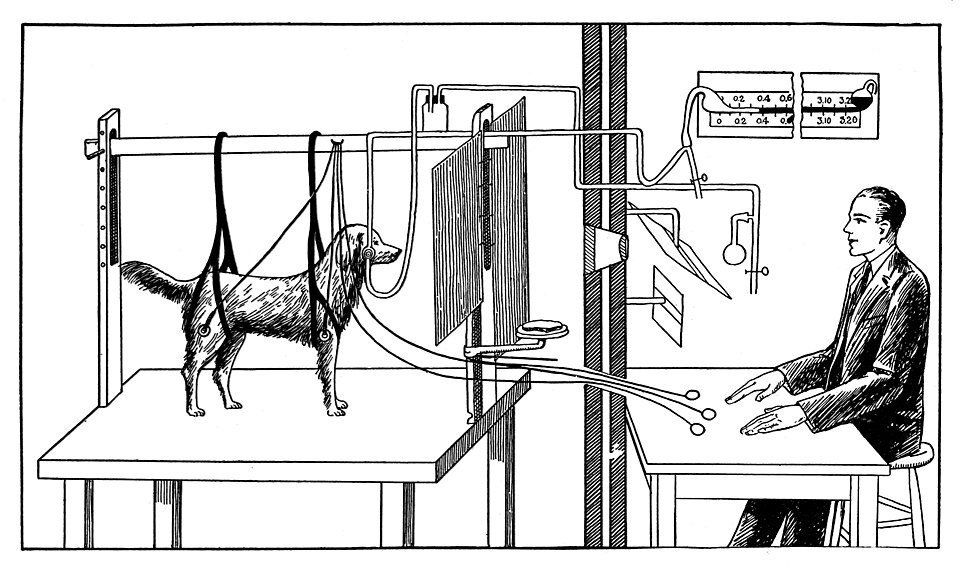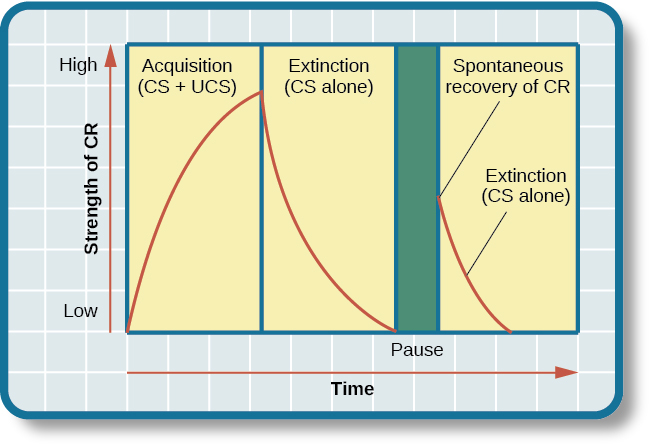IB Syllabus focus:
'- Principles of classical conditioning
- Implications for human behavior
- Modern perspectives and applications'
In the early 20th century, Russian physiologist Ivan Pavlov conducted experiments that would lay the foundation for the study of classical conditioning, an essential topic in the field of behavioural psychology. This investigation into Pavlov's Dogs sheds light on the process through which certain stimuli can be conditioned to elicit specific responses.
Principles of Classical Conditioning
Classical conditioning, also known as respondent conditioning or Pavlovian conditioning, is a learning process wherein a neutral stimulus becomes associated with a naturally occurring stimulus, eventually triggering a similar response.
Unconditioned and Conditioned Stimuli & Responses
Unconditioned Stimulus (US): A stimulus that naturally and automatically triggers a response without any learning.
Unconditioned Response (UR): The natural reaction that occurs in response to the US.
Conditioned Stimulus (CS): A previously neutral stimulus that, after being paired repeatedly with the US, starts to trigger a conditioned response.
Conditioned Response (CR): The learned response to the conditioned stimulus, typically resembling the UR.

This diagram illustrates classical conditioning: food (US) naturally elicits salivation (UR), while a neutral cue becomes a conditioned stimulus (CS) through pairing and elicits a conditioned response (CR). The sequence clarifies how an initially neutral signal gains predictive value. Source.
Pavlov's Experiment
Ivan Pavlov demonstrated this phenomenon using dogs, a metronome, and food:
The presence of food (US) caused the dog to salivate (UR).
Pavlov introduced a metronome (a ticking sound) just before giving the dog food.
After several repetitions, the dog began to salivate (CR) just at the sound of the metronome (CS), even without the food.

A laboratory dog fitted with a salivary fistula and collection apparatus used in Pavlov’s experiments. The setup enabled objective measurement of salivation when the conditioned stimulus was presented. This historical image adds procedural realism to the conditioning sequence described above. Source.
Acquisition, Extinction, Spontaneous Recovery
Acquisition: The initial stage in classical conditioning wherein the CS is linked with the US so that the CS begins to trigger the CR.
Extinction: The diminishing of the conditioned response when the CS is presented repeatedly without the US.
Spontaneous Recovery: The reappearance of a weakened CR after a pause, suggesting that extinction isn't about unlearning but about creating a new learned association.

The graph shows the conditioned response strengthening during acquisition, declining with extinction, then reappearing after a pause as spontaneous recovery. This pattern supports the view that extinction suppresses rather than erases the original learning; subsequent extinction follows more rapidly. Note that the figure also labels generalization/discrimination in surrounding text on the same page, which is beyond what is strictly required here. Source.
Implications for Human Behaviour
Pavlov's experiments, though conducted on dogs, have wide-ranging implications for understanding human behaviour.
Learning and Associations
Humans, like dogs, form associations between stimuli. For instance, the sound of an alarm clock (CS) can make someone feel anxious (CR) if it’s associated with an important exam.
Our emotional responses to various situations can be traced back to certain learned associations, which can sometimes be the root cause of irrational fears or phobias.
Behaviour Modification
Classical conditioning has been employed in therapies to modify undesirable behaviours.
Systematic Desensitisation: Used to treat phobias, where a person is gradually exposed to the fear-inducing stimulus in a controlled environment, often paired with a relaxation technique, thereby 're-conditioning' their response.
Marketing and Consumer Behaviour
Advertisers frequently use classical conditioning to create positive associations with products. For instance, pairing an advertisement (CS) with a popular song (US) might make consumers feel good (CR) about the product.
Modern Perspectives and Applications
Pavlov's foundational work has paved the way for numerous studies and applications in contemporary psychology.
Educational Settings
Positive Reinforcement in the Classroom: Teachers can pair positive reinforcement (US) with academic success to encourage a love for learning (CR).
Creating an Inclusive Environment: Pairing positive experiences with diverse cultures and backgrounds can foster an inclusive mindset among students.
Healthcare
Behavioural Therapies: Based on classical conditioning principles, therapies like exposure therapy help patients confront and reduce the power of fear-inducing stimuli.
Managing Addictions: By pairing an addictive substance with an unpleasant stimulus, patients can develop an aversion to the substance.
Technology and User Experience
Notification Alerts: Tech companies use sounds or vibrations (CS) to notify users, triggering a need to check the device (CR). Over time, this can lead to habitual behaviour.
In essence, understanding Pavlov’s work is crucial in appreciating how learned associations shape our behaviour. Whether in classrooms, clinics, or our daily lives, the principles of classical conditioning are ever-present, influencing how we respond to the world around us.
FAQ
In Pavlov's study, the unconditioned response was the natural, unlearned reaction of the dogs, which was salivation in response to food. It's termed "unconditioned" because it doesn't require any previous conditioning or learning. The conditioned response, on the other hand, was the learned response, which was salivation in response to the sound of the metronome. This response developed after repeated pairings of the metronome (conditioned stimulus) with the food (unconditioned stimulus), leading the dogs to associate the two.
In the context of classical conditioning, "extinction" refers to the gradual weakening and eventual disappearance of the conditioned response when the conditioned stimulus is presented repeatedly without being followed by the unconditioned stimulus. For example, if Pavlov's dogs heard the metronome repeatedly without then receiving food, over time, they would stop salivating in response to the metronome sound, demonstrating that the conditioned response had been extinguished.
Spontaneous recovery refers to the unexpected reappearance of a previously extinguished conditioned response after a pause. Even after extinction, the conditioned response can suddenly return, although typically weaker and more short-lived. Generalisation, on the other hand, occurs when stimuli that are similar but not identical to the conditioned stimulus also elicit the conditioned response. For instance, if Pavlov's dogs were conditioned to salivate to the sound of a specific metronome tone, they might also salivate to a similar tone, demonstrating generalisation.
Yes, classical conditioning principles can and have been applied to humans. One of the most famous examples is the "Little Albert" experiment by John B. Watson and Rosalie Rayner, where a young boy was conditioned to fear a white rat by pairing the sight of the rat with a loud, frightening noise. Over time, Little Albert began to cry and show fear in response to the rat alone. Furthermore, classical conditioning principles have been used in therapies for phobias and addictions, and in various aspects of everyday life, such as advertising. However, it's essential to consider individual differences and ethical implications when applying these principles to humans.
Pavlov chose dogs for his experiments due to their domesticated nature and observable salivary responses. Initially, he was studying the digestive processes of dogs and noticed that they would start salivating even before food was presented to them, such as at the sight of the lab assistant or the sound of footsteps. This observation sparked his interest in further understanding the associative learning process. Dogs were a convenient choice due to their controlled environment, consistency in responses, and ease of measurement of salivation.
Practice Questions
Pavlov's experiment with dogs illustrated the fundamental principles of classical conditioning. Initially, food (an unconditioned stimulus) was presented to the dogs, resulting in salivation (an unconditioned response). When a metronome (neutral stimulus) was consistently sounded just before the presentation of food, over time, the dogs began to associate the sound with the food. Eventually, the metronome alone, now a conditioned stimulus, elicited salivation, a conditioned response. This process demonstrated how a neutral stimulus can, through association with an unconditioned stimulus, evoke a learned response similar to the natural one.
Classical conditioning has greatly influenced modern behavioural therapies. One notable application is systematic desensitisation, used to treat phobias. In this therapy, individuals are gradually exposed to their fear-inducing stimulus in a controlled setting, often combined with relaxation techniques. Over time, the fear response diminishes. In addition, classical conditioning principles have been utilised in treating addictions. For instance, pairing an addictive substance with an unpleasant stimulus can help develop an aversion to that substance. Furthermore, advertisers leverage these principles to create positive associations with products, demonstrating the pervasive influence of classical conditioning in contemporary applications.

